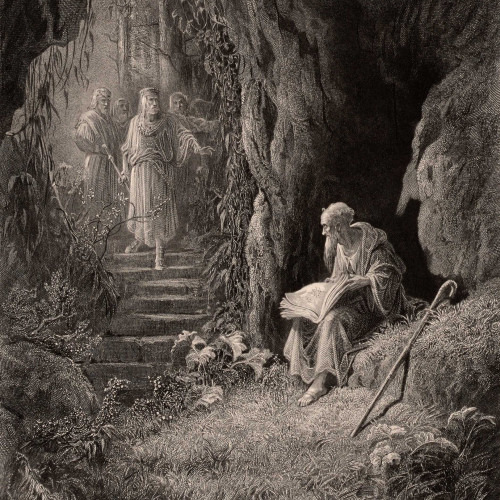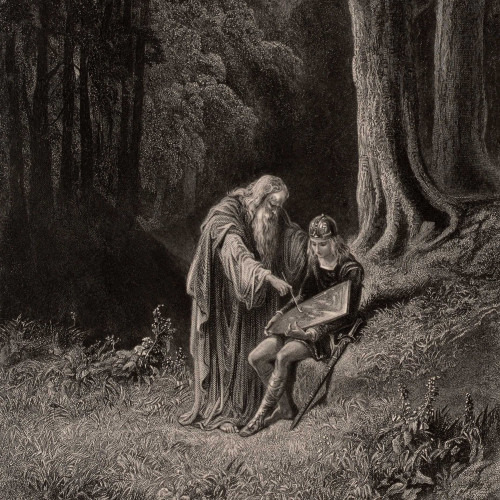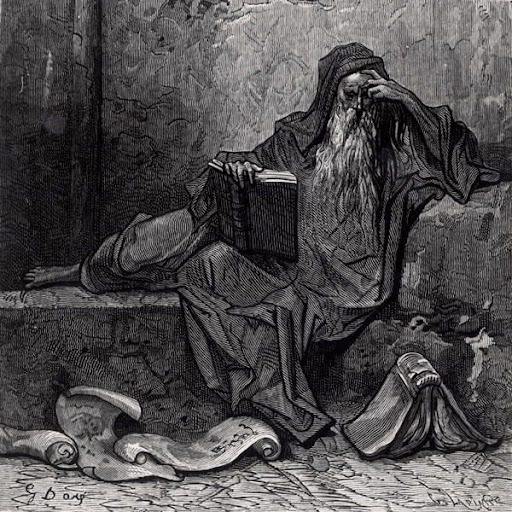#yves vadé
Explore tagged Tumblr posts
Text
Arthurian myth: Merlin (2)
A continuation of the loose translation of the "Merlin" article by Yves Vadé for the "Dictionnaire des Mythes Littéraires".

II/ Merlin in the Arthurian literature
As early as 1155, the Normand writer Wace transposed, for Alienor of Aquitaine, the “Historia Regum Britanniae” in French verse, in his “Roman de Brut”. He adds to the work the episode of the creation of the Round Table by Arthur, of whom Merlin will later become the prophet and the agent.
Merlin was barely mentioned by Chrétien de Troyes ; it is with Robert de Boron that he truly became the inspiration of the Grail’s knighthood. His work in verse, that contained at least the three romans known as “Joseph of Arimathea”, “Merlin” and “Perceval”, is partially lost in its original version, and it maybe even was unfinished. However, the prose translation of the “Merlin” was preserved, and seems to be quite faithful to Boron’s poem. The beginning of the roman takes back the motif of Merlin being born of an incubus demon, but it is now placed within a greater theological context: the demons wishes to produce an Antichrist, born of a virgin just like the Christ, in order to counter the Holy Incarnation. A demon managed, after some difficulties, to trick an honest young girl, but she immediately confessed her sin and she had the child baptized. From his father, the devil, Merlin received the knowledge of the entire past; and to counter this gift, God gave him the power to know the future. As such, Merlin is born with an universal knowledge. He uses it in the first months of his life to save his mother, threatened with burning at the stake ; then, at seven years old, he reveals to the usurper Vertigier the existence of the two dragons hidden under the foundations of his tower. He also reveals their meaning: the red dragon (Vertigier) will be killed by the white dragon (the young princes Pendragon and Uter, sons of the king Constant). Uter became king, and Merlin his advisor. He allows him to vanquish the Saxon during the battle of Salisbury, battle where Pendragon loses his life: Merlin had Stonehenge built in his memory, and Uter ruled under the name of Uterpendragon. A new element that would change the Merlin legend forever: it is through the idea and advice of Merlin that Uterpendragon has the Table of the Grail built, the “third table” after the one of Joseph of Arimathea, which itself was a copy of the table of the Last Supper. And, just like within Geoffroy’s work, it is thanks to Merlin that Uter can give birth to Arthur by uniting himself with the duchess Ygerne, that he marries soon after. Merlin raises Arthur in secret then he ensures his crowning and his rule. Merlin will keep assisting Arthur, so that both his kingdom and Christianity could prosper.
Visibly inspired by, if not written by, Robert de Boron, the “Perceval” of the Modène and Didot manuscripts give to Merlin a peaceful end, though an enigmatic one… After guiding Perceval through his quest, he announces the end of the enchantments within the Grail Castle. Once it is done, Merlin builds himself a home in the woods called “esplumeor” (a word with an unknown meaning). There, he escapes from both the flow of time and the sight of men, but he keeps making prophecies about what God asked him to reveal to humanity.

During the first half of the 13th century, two prose cycles formed themselves in France, each continuing Merlin’s story in a different way.
1) In the “Suite-Vulgate”, included within the greater cycle of the “Lancelot-Graal” or “Vulgate” (1215-1230), Merlin is the military advisor and strategist of Arthur in his battles against the barons that refuse his authority, then in his war against the Saxon, and finally in his feud against the emperor of Rome. Through Merlin, Arthur manages to marry Guenièvre, daughter of the king Laodegan, and he becomes the ruler in charge of the Round Table. But more importantly, it is here that Merlin encounters Viviane, the daughter of a lord named Dionas, at the edge of a fountain in the forest of Brocéliande. Wrapped around the tales of battles is a love story, during which Merlin allows Viviane to take away from him his magical knowledge. In order to keep Merlin all for herself, Viviane ends up capturing him within a “prison of air”, from where the prophet, now invisible, can still make his voice heard.
2) In the “Suite-Huth”, part of a cycle that was wrongly attributed to Robert de Boron, Merlin predicts the birth of Mordret, and the disasters caused by Balaain, the knight with two swords. It is Balaain that shall strike the “harmful blow” that will wound the king Pellehan and turn his kingdom in the “Terre Gaste”. Merlin is here much more involved in the adventures of the wandering knights than before. His role as an enchanter is put forward, as he is depicted commanding the wind, making the depiction of a dragon spit fire, open by magic the doors of a city, and preparing an enchanted bed that will remove from those that sleep within it their memory and their senses. The tale ends by the unfortunate love of Merlin and Viviane, which is a repetition of the love between Diana and Faunus. After bewitching Merlin, Viviane throws him into a vault whose stone cannot be removed. In his grave, Merlin screams one last time – and this last cry of the enchanter becomes the subject of an independent tale known as the “Conte du Brait”.
The first mention of Viviane is older than the “Suite-Vulgate”. She appears in the beginning of the “Lancelot” (or “Proper Lancelot”), under the name of Niniène, and she is depicted as a fairy of Bretagne that raised Lancelot in her wealthy domain hidden under a lake. Merlin appears here under a negative light. While his popularity is attested (it is said he was “so dreaded and so honored” by the people of Britany that all called him a “holy prophet” and common folks even called him a “god”), he is said to be “disloyal” and “deceiving” due to the nature of his father, and his knowledge is one of “perverse science”. The lady of the lake refuses his love out of wisdom, and she manages to trap him in “a cave within the dangerous forest of Darnantes”.
As such the character, that Robert de Boron tried to turn into the prophet of Christian knighthood, does not escape the ambiguity due to his composite origins, and which fits his genealogy, half-devil half-virgin. One can also see in his gift of shapeshifting a manifestation of his unstable personality, and of the contradiction of the several traits that compose him. This Proteus-like nature, certainly a remnant of the powers that were once attributed to the druids, allows Merlin to appear sometimes as a young man, sometimes as an old man, other times as a “woods-man/wild man”, and even as a great “branched stag”, as in the story of Grisandole (part of the “Suite-Vulgate”).

Built of successive additions, the tale of Merlin was reproduced, synthetized and translated, partially or entirely, by all the literatures of Europe until the end of the Middle-Ages. Even before 1250, the “Merlin” of Robert had been translated in the provençal language. The character also appears within numerous French verse romans of the 13th century: in “Fergus” (which places his lair in an isolated mountain), within “Le Chevalier aux Deux Epées”, within the “Roman du Hem”, within “Escanor”, within the “Roman de Silence” (where the Grisandole tale is found), and especially within “Claris et Laris”, which explains Merlin’s solitude by a crime he needs to expiate until his death. In the Prose Tristan (after 1240, Merlin takes care of Tristan, whose mother recently died, and gives him to a preceptor (just like he had done for Arthur in Robert de Boron’s text). Identified as a wizard, he builds a magical boat, the “nef de la joie”, for the king of Northomberlande. Outside of the knight-tales, a fairytale in verse of the beginning of the 12th century, “Du villain qui devient riche et puis pauvre”, also known as the “Dit de Merlin-merlot”, confirms the role among the “folk people” of Merlin as an embodiment of the supernatural.
The one that Dante called the “buon incantatore” was very popular in Italy, especially in relation to the work of Joachim of Flore. Among his apocryphal works there is an “Expositio Sibyllae et Merlini”. The tradition of Merlin as a prophet was enriched by a huge book of “Prophecies”, which mixed political predictions, sermons, and fictional stories. It was written in French between 1276 and 1279 by Venetian, probably a Franciscan. In the beginning of the 14th century, the Florentine Paolino Pieri mixed in his “Storia di Merlini” a tale of Merlin’s youth and the Italian translation of a part of the “Prophecies”. In 1480, Venice saw published six volumes of the “Historia di Merlino”, a great part also made of these prophecies supposedly made by Merlin.
In England, the “Merlin” of Robert and the “Suite-Vulgate” were recapped in a verse work known as “Arthour and Merlin” (1250-1300). Henri Lovelich gave an alternate version of this text in his “Merlin” (1430). A translation in Middle-English of the “Merlin-Vulgate” dates from the middle of the 15th century. Finally, sir Thomas Malory split the “Merlin” of Robert throughout the five first books of his “Morte d’Arthur”. This work, written in the prison of Newgate where Malory spent the last twenty years of his life, was printed in 1485 and constantly republished, and it ensured the fame of Arthur and Merlin within English-speaking countries.
In Germany, “Merlin und Seifrid de Ardemont”, by Albrecht von Scharfenberg (13th century) recaps Robert’s Merlin, with very important modifications (for example Pandragon and Uter are now the sons of Merlin). Other translations appeared in Holland. In Spain, the cycle of the pseudo-Robert de Boron was translated in the 14th century by the brother Juan Vivas, while the “Demanda del Sancto Grial” included a “Baladro del sabio Merlin”, derived from the lost “Brait de Merlin”. A Castilian version appeared at Burgos in 1498, and then another was published in Seville in 1535.
#merlin#merlin the enchanter#arthuriana#arthurian myth#arthurian literature#arthurian legend#medieval literature
24 notes
·
View notes
Text
alors apparemment le livre intitulé "les prophéties" (j'imagine celui dans lequel arthur trouve la prophétie qui concerne son mariage avec mevanwi) son auteur c'est censé être merlin... du coup j'imagine merlin qui a des espèces d'épisodes comme prisca où il rédige les prophéties mais il s'en souvient pas ensuite et personne est au courant que c'est son livre
30 notes
·
View notes
Photo

Girl Play with Snake Showing in OSMOSCOSMOS Curated by Joerg Bader and Alexandra Schüssler at Centre de la photographie Genève. 19th June - 25th August.
The exhibition OSMOSCOSMOS attempts to bring together two universes that are too rarely associated in our monotheistic cultures where sexuality is marked by guilt: Eros and cosmos. We can describe them as dynamic, as not static, not stable, not fixed. Jean-Pierre Vernant (1), specialist in ancient Greece and its myths, describes the meeting of the two: Eros - always in motion, between men and gods - witnessed the birth of the universe, allowing Uranus and Gaia to procreate. Gaia, who is emancipating herself from Chaos, needs the energy of Eros to unite with Uranus. Lying on his back and mating with Gaia, Uranus refuses to withdraw, despite the Titans they have just spawned and who are waiting to be born. Gaia encourages her future children to revolt and places a sickle handle in young Cronus' fist. He grabs the object to use it as a weapon and cuts off his father's sexual parts. This immense pain forces Uranus to pull away from Gaia with vehemence and upwards, forming the vault of the sky, the starry firmament, the Cosmos – forever.
Artist includes:
ROMY ALIZÉE
NOBUYOSHI ARAKI
JANE EVELYN ATWOOD
DOROTHÉE ELISA BAUMANN
HÉLÈNE BELLENGER
CAROLINE BERNARD
GÉRARD BERRÉBY
MATHIEU BERNARD-REYMOND
RENATE BERTLMANN
VIKTORIA BINSCHTOK
URSULA BÖHMER
MAUREN BRODBECK
MARA CATALÁN
MARINA CAVAZZA & GIULIA D'ANNA LUPO
FLORENCE CHEVALLIER
OLIVIER CHRISTINAT
NICOLAS CRISPINI
BUNU DHUNGANA
MAURICIO DIAS & WALTER RIEDWEG
CHRISTOPH DRAEGER
PHILIPPE DURAND & KLARA MEINHARDT
CHARLES & RAY EAMES
SANDRINE ELBERG
HANS-PETER FELDMANN
SABRINA FERNÁNDEZ CASAS
SYLVIE FLEURY
ENRIQUE FONTANILLES
JACQUES FOURNEL
LINDA FREGNI NAGLER & MICHAEL DOSER
PAUL-ARMAND GETTE
NADIA GRANADOS
VIVIENNE GRIFFIN
CHRISTIANE GRIMM
BARBARA HAMMER
HEIDI HASSAN
ASTRID JAHNSEN
NIKOLA JANKOVIC & SARAH VADÉ
DENIS JUTZELER
PHILIPP KEEL
PIERRE KELLER
MAJIDA KHATTARI
MARTIN KIPPENBERGER
JÜRGEN KLAUKE
CYRIL KOBLER
AMÉLIE LABOURDETTE
JEAN-JACQUES LEBEL
LEIGH LEDARE
EDEN LEVI AM
NICOLAS LIEBER
ARMIN LINKE
FRED LONIDIER
LEE LOZANO
URS LÜTHI
MANON
EDGAR MARTINS
ANGELA MARZULLO
FABIO MAURI
MICHEL MAZZONI
SUSAN MEISELAS
BJØRN MELHUS
FALK MESSERSCHMIDT
BORIS MIKHAILOV
CARLO MOLLINO
VERITA MONSELLES
GIANNI MOTTI
JEAN-LUC MOULÈNE
JOHAN ÖSTERHOLM
AURÉLIE PÉTREL
PETER PILLER
WALTER PFEIFFER
ROMAN PYATKOVKA
PIERRE RADISIC
CATHERINE RADOSA
KOKA RAMISHVILI
THOMAS RUFF
GREGOR SAILER
STUART SANDFORD
VIVIANE SASSEN
LINA SCHEYNIUS
LAURENT SCHMID
JO SPENCE
JULES SPINATSCH
ANNIE SPRINKLE & BETH STEPHENS
A.L. STEINER
STANLEY STELLAR
CLARE STRAND
ANNELIES ŠTRBA
JEAN TINGUELY
DANILA TKACHENKO
GRAZIA TODERI & ORHAN PAMUK
PATRICK TOSANI
NICOLE TRAN BA VANG
YVES TRÉMORIN
JAN VAN IJKEN
GILLES VERNERET
LILIANE VERTESSEN
CHRISTIAN WALDVOGEL
CHARLES WEBER
PATRICK WEIDMANN
BARBARA WOLFF
GIOVANA ZUCCARINO
6 notes
·
View notes
Text
“Le nom latin de Merlinus fait son apparition dans le monde lettré dès 1134 ou 1135 sous la plume de Geoffroy de Monmouth. C’est la latinisation du gallois Myrddin, soit par suite de la “tendance du d à se changer en l dans les langues indo-européennes” comme l’expliquait doctement d’Arbois de Jubainville, soit plus simplement pour éviter un fâcheux Merdinus.” 💀💀💀💀💀
10 notes
·
View notes
Text
alors apparemment l’animal de prédilection de merlin pour se transformer ce serait le saumon.
6 notes
·
View notes
Text
“Que Merlin fût meneur de loups n’aurait rien pour surprendre. Et qu’en est-il de Blaise, le maître qu’il va rejoindre périodiquement au fond des forêts et à qui, dans la littérature arthurienne, il est censé dicter le récit de ses aventures ? Serait-il un scribe réel nommé Bledhericus, alias Bleddri ap Cadifor, comme le soutient Jacques Roubaud ? Ne serait-ce pas plutôt un loup déguisé ? Il est tentant en effet de rapprocher le nom de Blaise du breton bleiz, blei (vieux-breton bleid, gallois blaidd...), désignant le loup.”
2 notes
·
View notes
Text
c'est "pour un tombeau de merlin" de yves vadé, comme tout ce que je taguerai avec le nom de cet auteur !
“Le nom latin de Merlinus fait son apparition dans le monde lettré dès 1134 ou 1135 sous la plume de Geoffroy de Monmouth. C’est la latinisation du gallois Myrddin, soit par suite de la “tendance du d à se changer en l dans les langues indo-européennes” comme l’expliquait doctement d’Arbois de Jubainville, soit plus simplement pour éviter un fâcheux Merdinus.” 💀💀💀💀💀
10 notes
·
View notes